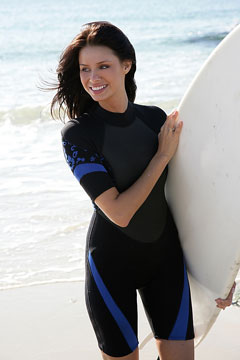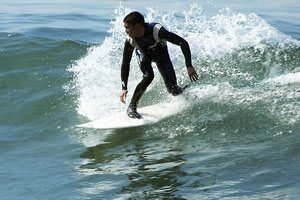Wetsuits
Wetsuit Guide - Water Sports Protective Apparel

 |
 A wetsuit will not keep you totally dry. Some water will seep in
through the seams, zipper, and bodily extremities; and this water will be
trapped in your suit and gradually warmed by your body temperature.
Each type of wetsuit seam construction – overlock, flat stitch, and
blind stitch – is designed for comfortable use at a different water
temperature range. Blind stitch construction is usually favored by
modern wetsuit makers. Blind stitch seams lay flat and are sewn
with curved needles so that the stitching does not completely penetrate
the neoprene layer.
A wetsuit will not keep you totally dry. Some water will seep in
through the seams, zipper, and bodily extremities; and this water will be
trapped in your suit and gradually warmed by your body temperature.
Each type of wetsuit seam construction – overlock, flat stitch, and
blind stitch – is designed for comfortable use at a different water
temperature range. Blind stitch construction is usually favored by
modern wetsuit makers. Blind stitch seams lay flat and are sewn
with curved needles so that the stitching does not completely penetrate
the neoprene layer.
 Wetsuit materials have improved in quality over the years, becoming
warmer, more flexible, and more durable. Wetsuit thickness is
measured in millimeters; the optimal thickness depends on the water
temperature, and the thickness in the torso area is often greater than
around the arms and shoulders. Typically, water temperatures
around 50 degrees Fahrenheit require a 7 mm diving wetsuit or a 5 mm
surfing wetsuit. Temperatures around 60 degrees Fahrenheit require
a 5 mm diving wetsuit or a 3 mm surfing wetsuit. Thicker wetsuits
generally keep their wearers warmer in cold water, but they tend to be
less flexible and restrict their wearers' freedom of movement.
Real cold water? Add booties. Arctic air? Get gloves
and a hood.
Wetsuit materials have improved in quality over the years, becoming
warmer, more flexible, and more durable. Wetsuit thickness is
measured in millimeters; the optimal thickness depends on the water
temperature, and the thickness in the torso area is often greater than
around the arms and shoulders. Typically, water temperatures
around 50 degrees Fahrenheit require a 7 mm diving wetsuit or a 5 mm
surfing wetsuit. Temperatures around 60 degrees Fahrenheit require
a 5 mm diving wetsuit or a 3 mm surfing wetsuit. Thicker wetsuits
generally keep their wearers warmer in cold water, but they tend to be
less flexible and restrict their wearers' freedom of movement.
Real cold water? Add booties. Arctic air? Get gloves
and a hood.
The three primary types of wetsuits are spring suits, full suits, and long johns. A spring suit, or shortie, covers its wearer's torso and thighs. It may have either short or long sleeves for its wearer's arms. A full suit, or steamer, covers its wearer's torso, legs, and arms, while a long john wetsuit covers only its wearer's torso and legs. In California, when the water is cold and the air is warm, a long john wetsuit is often the most comfortable choice. Wetsuit booties, gloves, and hoods are sometimes worn to provide extra warmth and protection from the elements.
Another popular wetsuit shape is the vest, which can be layered over a full suit for additional thermal protection. In Florida or Hawaii, a simple wetsuit vest may suffice to keep you warm in the water.
Wetsuit Manufacturers
- O'Neill
Wet suits, dry suits, rash guards, booties, hoods, gloves, and accessories.
us.ONeill.com - Body Glove
Full suits, spring suits, and accessories for surfing, diving, and general watersports.
www.BodyGlove.com - Henderson USA
Innovative designer of wetsuits, boots, gloves, and hoods for scuba divers.
www.HendersonUSA.com - Xcel Wetsuits
Offers a wide range of full suits and spring suits for surfers, as well as wetsuits for divers.
www.XcelWetsuits.com - Bare Wetsuits
Full and shorty wetsuits, dry suits, and accessories for cold water and warm water diving.
www.BareSports.com - Exceed Wetsuits
This Florida firm features wetsuits and rash guards for surfing, diving, and wakeboarding.
www.ExceedWetsuits.com - Rip Curl International
Manufacturer of wetsuits, surf wear, board shorts, surfboards, wakeboards, and accessories.
www.RipCurl.com
All rights reserved.
About us. Contact us. Search.
For your convenience, certain links will open in a new window.
Guide to Surfing Wetsuits and Diving Wetsuits
Recent Wetsuit News
- Scientists test bite-resistant wetsuits that could reduce shark attack damage
Flinders University researchers in Australia tested four bite-resistant wetsuit materials against white and tiger sharks, finding all reduced damage from shark attacks.
Fox News. Saturday, 27 Sep 2025 22:16:36 -0400. - This longtime SeaWorld dolphin trainer is also a San Diego cop. The police wetsuit says it all.
Sgt. Andre Thomas spends weekdays on police duty and weekends performing with dolphins
Teri Figueroa. San Diego Union Tribune. Sunday, 07 Sep 2025 12:00:58 +0000.
 Young Woman Wearing a Gray Wetsuit
Young Woman Wearing a Gray Wetsuit